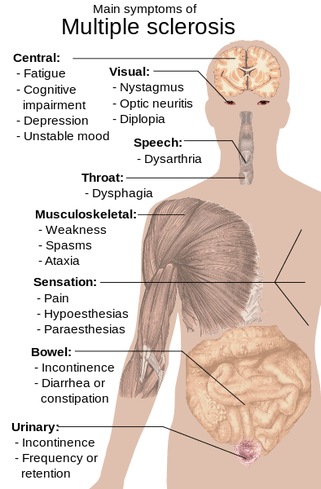NEW INFORMATION ABOUT MULTIPLE SCLEROSIS
THE MORE THINGS CHANGE, THE MORE THEY STAY THE SAME
|
“Biologists have demonstrated a connection between multiple sclerosis — an autoimmune disorder that affects the brain and spinal cord — and gut bacteria.” – The July 20, 2010 issue of Science Daily, talking about the research of Drs. Sarkis K. Mazmanian and Yun Kyung Lee of the California Institute of Technology
|
Multiple Sclerosis is an Autoimmune Disease that is the result of scarring (sclerosis) along the surface of the Brain and Central Nervous System which is the result of the body perceiving it’s own meylin sheaths (the insulation around the nerve system — the so called ‘white matter’) as foreign. Once the body recognizes a tissue as foreign, it makes antibodies against it and begins the attack. As you might imagine, the resulting symptoms can be far-ranging and include physical, cognitive, and even psychiatric problems. As is the case with virtually all Autoimmune Diseases, women are far more affected than men, and depending on when the disease first appears, it can shorten life span by as much as a decade.
I’m writing this post because four years after the Cal Tech study showing a strong link between the disease and Gut Bacteria, another major study is taking it a step further. Back in October, the medical journal PLoS ONE published a collaboration between Weill Cornell Medical College and The Rockefeller University in New York. Their conclusion is that the common bacteria (Clostridium perfringens – type B) produces a toxin which triggers MS. And although they were talking about animals in this case, listen to what the researchers wrote about what they think might trigger C Perfringens to trigger MS. “Neurologic symptoms occur when carbohydrate rich feed… favors exponential growth of the bacilli “.
The Clostridium family of bacteria are inclined to manufacture toxins. The most common is one that you have likely heard of — Clostridum Botulinum (Boltulism) —- the bacteria that BOTOX is made from. A 2012 study from the journal Veterinary Microbiology talked about the benefit of Proteolytic Enzymes (DIGESTIVE ENZYMES that break down protein — particularly the pancreatic enzyme Trypsin) in helping get rid of C. Perfringens infections. No matter how you slice it, the cliche from the old school natural doctors is just as true today as it ever was. Heal the gut, heal the body. But how does one go about healing the gut?
IS IT POSSIBLE TO HELP THOSE FIGHTING MULTIPLE
SCLEROSIS TO DO IT IN A MORE NATURAL MANNER?
In order to start this process, it means you’ll have to take some serious responsibility for your health. For one thing, you are going to have to study. Knowledge is power, and you can start by gaining a cursory understanding of things like TBI’S, INFLAMMATION (not one in a thousand people have any idea what it really is), GLUTEN SENSITIVITY, LEAKY GUT SYNDROME, BLOOD SUGAR (remember the quote about carbohydrate rich feeds from above?), ANTIBIOTICS, PROBIOTICS, DYSBIOSIS, and GUT HEALTH. And that’s just for starters. You’ll also need to figure out which DIET will be the best for your particular situation.
I have put together some very generalized information HERE and HERE that may help you understand the process that will be needed to get the bull by the horns and start taking charge of your own health. If you have further questions you can contact me or make an appointment with someone in your area — preferably someone who practices FUNCTIONAL NEUROLOGY and Functional Medicine.

